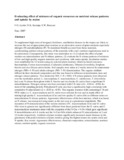| dc.contributor.author | F.O, Ayuke | |
| dc.contributor.author | N.K, Karanja | |
| dc.contributor.author | S.W, Bunyasi | |
| dc.date.accessioned | 2013-02-25T14:47:23Z | |
| dc.date.issued | 2007 | |
| dc.identifier.citation | A. Bationo (eds.), Advances in Integrated Soil Fertility Research in Sub-Saharan Africa: Challenges and Opportunities, 833–844, 2007 | en |
| dc.identifier.uri | http://erepository.uonbi.ac.ke:8080/xmlui/handle/123456789/11240 | |
| dc.description.abstract | To supplement high costs of inorganic fertilizers, smallholder farmers in the tropics are likely to increase the use of appropriate plant residues as an alternative source of plant nutrients especially nitrogen (N) and phosphorus (P). To maximize benefit accrued from these materials, synchronizing nutrient release patterns of the materials with crop’s nutrient requirements need to be understood. Consequently, this study was undertaken to: (1) evaluate the effect of plant residues on mineralization and N-release patterns, (2) evaluate the N release patterns of mixtures of low and high quality organic materials and synchrony with maize uptake. Incubation studies were established for 12 weeks using six selected plant residues: which included Leucaena leucocephala, Croton macrostachyus,
Calliandra calothyrsus, Tithonia diversifolia, Sorghum bicolor and rice (Oryza sativa) husks. Soil samples were taken at 2 weeks interval for ammonium nitrogen (NH+
4 -N) and nitrate nitrogen (NO−3 -N) determination. The organic residues differed in their chemical composition and this was found to influence mineralization rates and nitrogen release patterns. Two distinctive NO−3 -N + NH+ 4 N release patterns were observed over the incubation period. L. leucocephala, C. macrostachyus, C. calothyrsus, T. diversifolia had a net N release throughout while S. bicolor and rice husks (O. sativa) had a significant N immobilization. Nitrogen-release was best correlated with C:N ratio (r2= –0.84 to –0.90) for most of the sampling periods. Polyphenol:N ratio also had a significantly high correlation with cumulative N mineralized (r2 = –0.65 to –0.95). Two organic resource with contrasting C:N and PP:N ratios i.e. C. macrostachyus and O. sativa were selected for use and in depth effect of mixing high quality C. macrostachyus (Cm) and low quality O. sativa (Os) at different ratios on mineralization N release patterns. Agronomic effectiveness of the best mixture, which was based on N release, was measured using maize as the test crop in a glasshouse experiment. The dynamics of N-mineralization
of the various mixture of C. macrostachyus (Cm) and O. sativa (Os) were in general not significantly different from those predicted from the O. sativa and C. macrostachyus treatments alone with the exception of the ¾ Cm + ¼ Os which gave significant N immobilization at 6–8 weeks and the ¼ Cm+¾Os which enhanced N mineralization at 2
and 12 weeks respectively. Addition of plant residues significantly increased maize biomass in the glasshouse with potted mixtures of plant residues giving the highest maize dry matter yield and N uptake. Key words: Agronomic effectiveness, chemical composition, mineralization, nutrient release, nutrient uptake, organic resources | en |
| dc.language.iso | en | en |
| dc.publisher | Springer | en |
| dc.subject | Agronomic effectiveness | en |
| dc.subject | Chemical composition | en |
| dc.subject | Mineralization | en |
| dc.subject | Nutrient release | en |
| dc.subject | Nutrient uptake | en |
| dc.subject | Organic resources | en |
| dc.title | Evaluating effect of mixtures of organic resources on nutrient release patterns and uptake by maize | en |
| dc.type | Book chapter | en |
| local.publisher | Department of Soil Science, College of Agriculture and Veterinary Medicine, University of Nairobi | en |
| local.publisher | Department of Applied Biology, Faculty of Science, Kenya Methodist University | en |
| local.publisher | Coffee Research Foundation (CRF), Sagana, Kenya | en |

